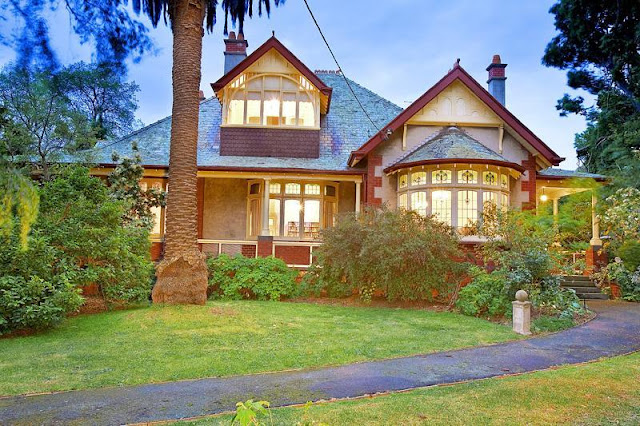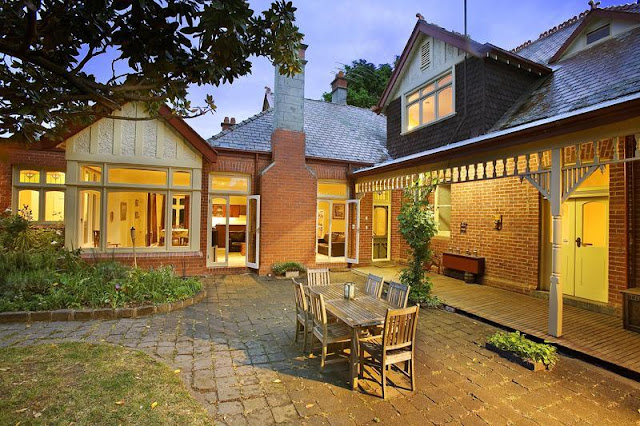Picturesque Queen Anne Architecture in Melbourne
Table of Contents
- See also Melbourne Queen Anne
- See also Melbourne's Federation Heritage
- See also Hawthorn Federation Architecture
- See also Federation Queen Anne style
pic•tur•esque (adj.)
- visually charming or quaint, as if resembling or suitable for a painting:
a picturesque village. - (of writing, speech, etc.) strikingly graphic or vivid.
- having pleasing or interesting qualities; strikingly effective in appearance.
In England, the picturesque was defined as an aesthetic quality existing between the sublime (i.e., awe-inspiring) and the beautiful (i.e., serene), and one marked by pleasing variety, irregularity, asymmetry, and interesting textures.
- For example, medieval ruins in a natural landscape were thought to be quintessentially picturesque.[1]
 |
| Asymmetrically designed garden |
| Downton Castle in a 'picturesque' landscape (designed to please the eye) |
- Picturesque beauty is a historical development of taste or style, which means ‘after the manner of painters’.
Painters, it was realized, had a special way, a highly visual way, of looking at nature. - The Queen Anne Revival in architecture grew alongside a taste for Gothic Architecture. "Picturesque Gothic began as informal architecture featuring gothic decoration placed picturesquely to... enhance a view in a picturesque garden."
- Below it is picturesquely compared to Downton Abbey, actually Highclere Castle, a throwback to classical design.
- Of Downton Castle: "Its irregular features are at once apparent:
- Square and octagonal towers abut from the walls in the form of huge irregular bastions;
- the window arrangements are irregular, some windows are flat, some are crowned with pointed arches,and some oriels[1]
|
|
|
|
|
- Picturesque taste is concerned with foregrounds, distances, and second distances; side screens and perspectives; lights and shades; [2]
- There are various follies and eye-catchers on the Highclere estate. "Heaven's Gate" is an eye-catcher about 18 m high onSidown Hill, from a design by Capability Brown in 1774–1777
Queen Anne Style
Derived from English and American styles that revived elements from the architecture of Queen Anne’s reign (1702-14), these picturesque houses are deliberately complex, creating a kind of vigorous grandeur.
- Most of these houses are freestanding and set well back from the street.
- Houses usually have complex roof forms and asymmetrical floor plans.
- The roof form is a key feature of these houses.
So why is an architectural style popular in late 19th and early 20th century Australia named after a queen who ruled Great Britain around two hundred years earlier?
- Queen Anne was neither an architect, nor a passionate proponent of architecture, but the Queen Anne style revives architectural details reminiscent of the buildings around at her time.
- Both Britain and America have Queen Anne revival architecture, and although similar, the Australian variety is quite unique.
- In Australia, Queen Anne refers to an eclectic style of red brick buildings with ornate detailing and old-world elegance.
- The Queen Anne style is romantic, picturesque architecture. The complex rooflines with terracotta chimney pots are the most striking feature of the style.[3]
|
|
Picturesque Parkville:
Auld Reekie, 511 Royal Parade Parkville
The house known as 'Auld Reekie at 511 Royal Parade in Parkville dates from 1910, but possibly incorporates an earlier six roomed villa named 'May Day/ which had been built in 1872 by a butcher called Henry Harper. 'Auld Reekie' was constructed by Alexander and Jessie Sturrock who purchased the site in 1908.- 'Auld Reekie' is built from red brick with a hipped-gable Marseilles tile roof decorated by tall chimneys, terra cotta chimney pots, ridging, scroll and dragon finials. The belvedere, attic with balcony and verandah complete the picturesque composition.
- Internally the entrance hall is hexagonal with five rooms radiating outwards. Throughout the five front rooms all the joinery and fittings are original including lead lighting to many of the windows. The ceiling in the sitting room is hand painted with Art Nouveau foliated relief work. The hall has intact blackwood joinery with elaborate door surrounds and fluted pilasters and carved pedimental motifs. The floor is divided into marble squares.
- The first floor verandah has an iron balustrade featuring a gum leaf pattern. The front fence is a iron palisade, with scroll shaped picket finials. The fence is set on a plinth of rusticated bluestone blocks. There is an off centre gateway, the metal gate in the shape of a shield, which is flanked by pink and white marble castellated octagonal posts with relief carving to each panel. The marble was imported from Italy. The other posts supporting the palisade are a smooth sided bollard shape with domed tops.

"Auld Reekie is the last remaining example of the grand mansions once gracing Royal Parade. Fully restored with exceptional craftsmanship, featuring 13 principle rooms over two storeys. Large site area of 2,400 sqm with 30 metre frontage. The 20 metre lap pool forms the centre piece of a lush well established garden."
Nocklofty, 551 Royal Pde, Parkville
Nocklofty is a single storey Federation style brick villa at 551 Royal Parade, Parkville.- It was designed and built by the owner Kenneth Munro between 1906 and 1908. Munro, a retired mining and construction engineer and highly accomplished amateur wood carver, executed all the original exterior and interior decoration and pattern for casting the verandah columns and friezes in terracotta.
- Work commenced on the house in January of 1906, soon after Munro's retirement as an Engineer, but at the beginning of his career as a skilled woodcarver. The single storey house is constructed in brick and has a verandah and front bay window and a Basel Mission terra cotta tile roof. A belvedere, with a conical roof, surmounts the roof-line. The style of the house was influenced by northern European house design and wood carving traditions and by the Arts and Crafts movement. The face red brickwork, with bands of Mount Gambier limestone and ornamental tiles, was originally unpainted. Windows contain diamond leadlights and stained glass lead lights with Art Nouveau designs.
- Munro carved the ornamental wood work for Nocklofty in the workshops constructed adjacent to the stables. In particular his work can be seen in Californian Redwood bargeboards, depicting gum leaves and nuts, and on the verandah which is supported by terracotta columns and bases, cast at Cornwall Potteries in Brunswick to Munro's own designs. Internally Munro has carved impressive jarrah overdoors and overmantels, with fauna and flora, such that each carved piece symbolises the use of the room. An eagle spreads its wings on the overmantel of the dining room, whilst the overdoor is carved to depict grapes. Carved cockatoos perch on the master bedroom overdoor. The children's bedroom was crowned by magpies and an owl, the bathroom by water lilies and an egret. The hall stand and bench contain the Munro coat of arms.
Nocklofty at 551 Royal Parade Parkville on 1,700sqm of land was on the market for $5 million via Expression of Interest campaign closing 25 October 2012. The property last sold in December 1979 for $250,000. Heritage listed.
- The external aesthetic of the brick-fronted Federation Queen Anne style home is elaborate, if quite typical of the period. However, the interior woodworking completed in part (or in entirety) by Munro himself overflows with Australian patriotism: Californian redwood barges carved with gum nuts and leaves, and cockatoos perch above the master bedroom door.
The hall stand and bench contain the Munro coat of arms. |
Lenoma, 7 Chrystobel Crescent, Hawthorn
 |
| Picturesque Lenoma |
Gracious and spacious 'Lenoma' is a uniquely peaceful and private family haven having street and parkland frontage in the exclusive heart of the prestigious Grace Park Estate.
 |
| Asymmetrical, complex roof line |
- Sited on a beautifully established 1,865 sq. metre (20,074 sq ft) double garden allotment that extends north to Mary Street, this gracious 6 Bedroom and Study Federation residence c1910 is a grand two-level domain of rich original charm and light that has tastefully evolved for superb living and secluded poolside entertaining.
- Perhaps the best example of the era in Hawthorn.

 |
| Asymmetrically designed garden |
 |
| Rotha, 29 Harcourt Street, Hawthorn East; Rotha is unique in anticipating the Australian Queen Anne style of architecture not popularised until the end of the 19th century. Rotha was designed by the notable nineteenth century architect John Beswicke as his own residence. The house was built in 1887. |
References:
- http://radicalterrace.com/post/32429317830/nocklofty-551-royal-parade-parkville-vic
- http://www.environment.gov.au/cgi-bin/ahdb/search.pl?mode=place_detail;search=state%3DVIC%3Bkeyword%3Dpicturesque%3Bkeyword_PD%3Don%3Bkeyword_SS%3Don%3Bkeyword_PH%3Don%3Blatitude_1dir%3DS%3Blongitude_1dir%3DE%3Blongitude_2dir%3DE%3Blatitude_2dir%3DS%3Bin_region%3Dpart;place_id=14945
http://www.domain.com.au/Property/For-Sale/House/VIC/Parkville/?adid=2005563759 - http://www.walkingmelbourne.com/forum/viewtopic.php?f=4&t=7242
- http://www.domain.com.au/Property/For-Sale/House/VIC/Hawthorn/?adid=2006818550
- ^ http://www.britannica.com/EBchecked/topic/459638/picturesque
- ^ http://shaps.unimelb.edu.au/public-resources/database-resources/bernardsmith/lectures/BSmith-Picturesque1.pdf
- ^ Jane Austen, Northanger Abbey -- Chapter 14
- ^ http://heritage.vic.gov.au/Heritage-places-objects/What-house-is-that/queen_anne.html








No comments:
Post a Comment